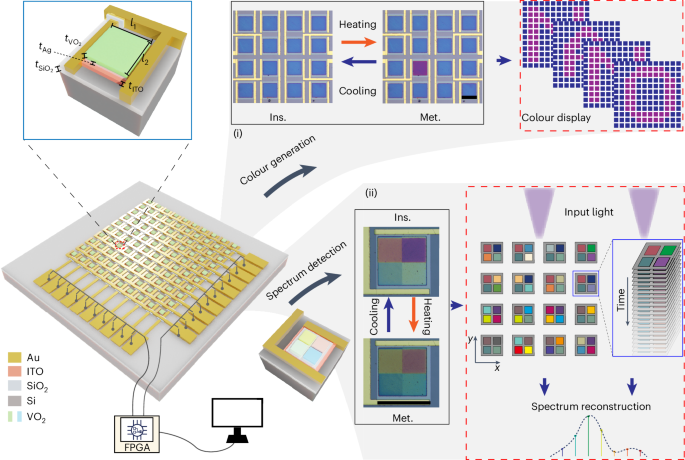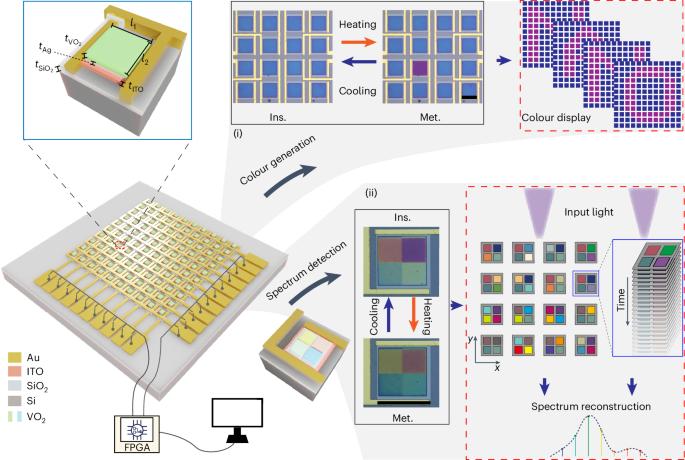耐用且可编程的超快光谱像素纳米光子矩阵
IF 38.1
1区 材料科学
Q1 MATERIALS SCIENCE, MULTIDISCIPLINARY
引用次数: 0
摘要
局部可寻址纳米光子器件对于光检测、光学成像、光束转向和显示等现代应用至关重要。尽管最近取得了一些进展,但具有高速调谐率、长寿命耐久性和多像素可编程性的多功能解决方案仍然遥遥无期。在这里,我们介绍一种可编程纳米光子矩阵,它由像素化微加热器上的二氧化钒(VO2)空腔组成,能够满足所有这些要求。这些二氧化钒空腔的间接焦耳加热可产生明显的光谱调制和颜色变化,并确保即使在百万次开关周期后仍具有超强的耐用性。通过优化厚度的二氧化硅层对热耗散功率进行精确控制,可实现超过 70 kHz 的超快调制速率。我们通过对 12 × 12 像素矩阵进行电子寻址,展示了视频速率纳米光子彩色显示屏。此外,受独特的像素级可编程性和光谱像素的多种中间状态的启发,我们还引入了用于光谱检测的时空调制概念。本文章由计算机程序翻译,如有差异,请以英文原文为准。


Durable and programmable ultrafast nanophotonic matrix of spectral pixels
Locally addressable nanophotonic devices are essential for modern applications such as light detection, optical imaging, beam steering and displays. Despite recent advances, a versatile solution with a high-speed tuning rate, long-life durability and programmability across multiple pixels remains elusive. Here we introduce a programmable nanophotonic matrix consisting of vanadium dioxide (VO2) cavities on pixelated microheaters that meets all these requirements. The indirect Joule heating of these VO2 cavities can result in pronounced spectral modulation with colour changes and ensures exceptional endurance even after a million switching cycles. Precise control over the thermal dissipation power through a SiO2 layer of an optimized thickness on Si facilitates an ultrafast modulation rate exceeding 70 kHz. We demonstrated a video-rate nanophotonic colour display by electrically addressing a matrix of 12 × 12 pixels. Furthermore, inspired by the unique pixel-level programmability with multiple intermediate states of the spectral pixels, a spatiotemporal modulation concept is introduced for spectrum detection. Electrically addressable VO2 elements show large resonance shifts during phase transitions, producing a brilliant colour change at a modulation rate of 70 kHz.
求助全文
通过发布文献求助,成功后即可免费获取论文全文。
去求助
来源期刊

Nature nanotechnology
工程技术-材料科学:综合
CiteScore
59.70
自引率
0.80%
发文量
196
审稿时长
4-8 weeks
期刊介绍:
Nature Nanotechnology is a prestigious journal that publishes high-quality papers in various areas of nanoscience and nanotechnology. The journal focuses on the design, characterization, and production of structures, devices, and systems that manipulate and control materials at atomic, molecular, and macromolecular scales. It encompasses both bottom-up and top-down approaches, as well as their combinations.
Furthermore, Nature Nanotechnology fosters the exchange of ideas among researchers from diverse disciplines such as chemistry, physics, material science, biomedical research, engineering, and more. It promotes collaboration at the forefront of this multidisciplinary field. The journal covers a wide range of topics, from fundamental research in physics, chemistry, and biology, including computational work and simulations, to the development of innovative devices and technologies for various industrial sectors such as information technology, medicine, manufacturing, high-performance materials, energy, and environmental technologies. It includes coverage of organic, inorganic, and hybrid materials.
 求助内容:
求助内容: 应助结果提醒方式:
应助结果提醒方式:


